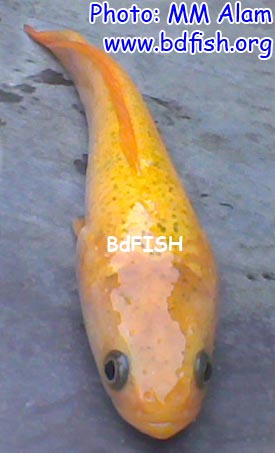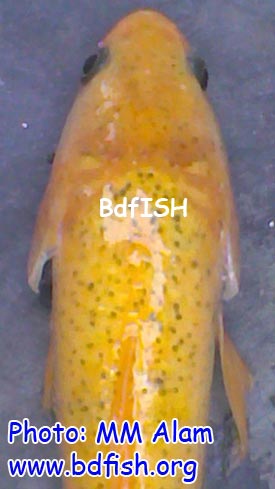
Presence of numerous black spot on the bright-orange body surface of the fish makes it different from other five snakehead species in Bangladesh although the external characters are same. The external characters of the fish mostly found to be similar with Channa barca but a critical difference is found while comparing the body colour of these two specimens. The body colour of Channa barca is black spots on grayish-black skin but the new specimen is completely bright orange coloured with black spots.
Therefore, gradually a question arises that, is this change of colour occurs due to the breeding periodicity of the fish? But this possibility is very less because no record of colour changes of Channa barca is found elsewhere during the breeding season. Even the present time (November) is not the breeding period of Channa barca. Then would we think the specimen as a new species of snakehead in Bangladesh?

Based on photographs from different angles of only one specimen I discussed with my colleague Dr. ABM Mohsin working with fish diversity; and using taxonomic key of renowned websites like FishBase and compiling the other available important related documents, the maximum characters of the fish are found to be similar with Channa bleheri of Assam (India) where the fish is known as ‘Lal Cheng’ [Eng. Red Snakehead].
The fish is found in the aquarium fish markets of Europe and America as an ornamental fish, commonly known as Rainbow snakehead. Sellers of these markets breed the fish commercially by following artificial breeding technique. In Bangladesh, no record of this fish has been found in the Katabon aquarium fish market of Dhaka; even the seller of this market did not import the fish earlier. Then, how dose the fish come in Tangail area? Dose it come from Assam during flood?
Further more study is needed for this purpose. So, we are not placing our comment about the fish now. Discussions are started with renowned fisheries scientists of Bangladesh about the matter and hope the species name of the fish will be confirmed soon.
Photographs from different views are inserted here which clearly differentiates the fish from the other five snakeheads of Bangladesh. The available five species of snakehead in Bangladesh are-
- Spotted snakehead, Channa punctata (Bloch 1793), Taki [টাকি]
- Shol, Channa striatus (Bloch 1793), Shol [শোল]
- Great snakehead, Channa morulius (Hamilton 1822), Gogar [গজার]
- Walking snakehead, Channa orientalis Bloch and Schneider 1801, Channa gachua (Hamilton 1822), Chang [চ্যাং]
- Barca snakehead, Channa barca (Hamilton 1822), Tila shl [তিলা-শোল]

Specimen collection: Place and period
A pond of village Boruha of Tangail Sadar Upazila has become a dwelling place of various wild and native fishes of Bangladesh. In each rainy season the pond goes under water and connect with the adjacent low-land areas that become the breeding and feeding ground of these species. During over flood, this area connects with the “Alongjani River” (A branch of the river “Dholeshawari”) by a canal. The connection is occurred easily this year due to over flood. The fish is captured from the mentioned pond while angling on 12 November 2011. After taking photographs from different angles the fish is released in the pond aimed to natural conservation for further research. Other ponds of that area are kept under observation expecting to find another specimen.
তথ্যসূত্র:
- www.fishbase.org
- FishBase Fish Identification
- fl.biology.usgs.gov
- www.seriouslyfish.com
- www.aquaticcommunity.com
- www.jjphoto.dk
- Day F. 1958. The Fishes of India: being a Natural History of the fishes known to inhabit the seas and freshwater of India., Burma and Ceylon. Reproduced in 1958 by William Dowson andSons, London.
- IUCN Bangladesh (2000) Red book of threatened fishes of Bangladesh, IUCN- The world conservation union. xii+116 pp.
- Munro ISR (2000) The marin and freshwater fishes of Ceylon. Dept. of External affairs, Canberra.
- Rahman AKA (1989) Freshwater Fishes of Bangladesh, 1st edition, Zoological Society of Bangladesh, Department of Zoology, University of Dhaka, Dhaka-1000.
- Rahman AKA (2005) Freshwater Fishes of Bangladesh, 2nd edition, Zoological Society of Bangladesh, Department of Zoology, University of Dhaka, Dhaka-1000.
- Shafi M and Quddus MMA (2001) Bangladesher Matsho Shampad (Fisheries of Bangladesh) (in Bengali), Kabir publication. Dhaka, Bangladesh.
- Talwar PK and Jhingran AG (1991) Inland Fishes of India and Adjacent Countries, Vol. 2, Oxford & IBH Publishing Co. Pvt. Ltd. New Delhi-Calcutta.

Acknowledgement
- Mr. Md. Jakaria Islam, who first shown me the specimen after collection.
- Dr. ABM Mohisn, Associate Professor, Department of Fisheries, University of Rajshahi and co-author of this feature.
Experts’ comments regarding the fish
- Professor Dr. M.S. Shah
Professor of Fisheries Genetics, FMRT, KU and Vice-chancellor, Khulna University, Khulna-9208, BangladeshI have seen the photograph of the fish and I am sure this is not a separate species of the Channa genus. The phenotype is due to the action of a semi-lethat gene albino and it results in 100% reduction of melanophore from the body with pink eyes; if the gene is fully lethat in action the individuals carrying the carrying the gene do not survive and die at various stages of fertilization and hatching. In the present case, the gene being semi-lethat it does not kill all the progenies in the batch/brood but allows the survival of a limited number of individuals, while others die at post-fertilization and at different stages of hatching and development. That is why the prevalence/occurrence of the phenotype in the natural populations is very very rare. This means you would not necessarily expect to find many of the individual phenotype in the nature.
- Dr Md Mukhlesur Rahman Khan
Professor, Dept of Fisheries Biology and Genetics, BAU, Mymensingh, BangladeshThank you for your collection of sneak head fish. Please preserve it in alcohol if this fish died. My assumption is that this is Channa punctatus albino. Also I need more taxonomical information for comparison. If you are interested then I could do more work with molecular markers for confirmation.
- Dr. M. Saiful Islam
Professor of Zoology (Specialization on Genetics), University of Rajshahi, Rajshahi 6205, BangladeshI’m not sure, but would you consider that this snakehead could be an albino (without usual pigments) form of the fish species? What about body meristic and morphometric features? Keep me informed of any progress of it.
- Dr. Mohammad Firoj Jaman
Associate Professor, Department of Zoology, University of Dhaka, Dhaka 1000, BangladeshThanks for mail and sending me the picture of a fish. Its look like different from the other snake-headed fish. However, details genetic and texonomic study are necessary before concluding about this fish specimen
- Comment of an expert forwarded by Dr. Md. Yeamin Hossain
Lecturer, Department of Fisheries, University of Rajshahi, Bangladesh and JSPS Post-Doctoral Fellow, Faculty of Fisheries, Kagoshima University, 4-50-20 Shimoarata, Kagoshima 890-0056, JapanI have never seen a snakehead having such orange body color so far besides albino individuals. It is difficult to observe morphological characters besides its body color, some black spots on predorsal region, body and head shape from the photograph.
I think that there are two possibilities.
- Albinism of already known species of snake heads. I have seen some albino individuals of some species of snakeheads such as Channa striata. Most of them are in yellowish, goldish or orangish color.
- Unknown (un-described) species or at least a species which is presently not recognized as valid.
However, to judge its status, direct examination of the specimen is necessary. Other morphological characters besides coloration including scale and fin ray counts, absence or presence of scales on undersurface of lower jaw, absence or presence and length of pelvic fin have to be studied in detail. Initially, you can use this key to identify the species.
Additionally, even it is merely an albino individual of already known species, it is worth reporting since there is no report (paper) on albinism found in nature of snakeheads.
Note:
This page will be updated continuously until the species is identified properly. Readers of this document are requested to comment about this fish if they have any document regarding concerned fish.
Visited 4,934 times, 1 visits today | Have any fisheries relevant question?
